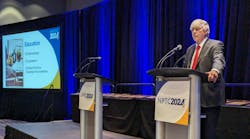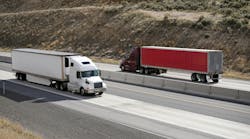Truck and trailer suspensions are on the verge of revolutionary design developments, rather than just more of the evolutionary ones that have been evident most recently.
“As an industry, we've made great strides in improving ride and stability of suspensions while taking out weight,” points out Sean Coleman, marketing manager for Hendrickson International's truck suspension div. “But diminishing returns make it harder to continue those trends. So now we're looking at making revolutionary changes by adding things like adaptive electronic controls for better suspension management.”
The main pillar supporting future developments is the increased use of air-ride suspensions on both trucks and trailers in an ever-widening array of truck applications. More than 68% of all the trailers on the road today are equipped with air-ride suspensions, states Gary Ciapetta, director of marketing for Hendrickson's trailer division. Even dump trailers are now air-ride equipped in many cases, he notes, since fleets are finding that stability and handling have improved markedly.
Another factor has been the shift toward building “integrated” suspension systems. Dan Chen, director of ArvinMeritor's new suspension business unit, says that manufacturers are no longer trying to “piece” together truck and trailer suspensions — with one company building axles, another one building leaf springs, and then the truck or trailer maker assembling all the components together at the final stage.
Rather, Chen says much of the suspension industry has moved toward designing and building suspensions as complete “modules” — manufacturing the axles and all other suspension components with an eye toward reducing both weight and cost.
THE SAFETY FACTOR
A side benefit of recent improvements to suspension design is greater vehicle safety. And safety will play an increasing role in future suspension design efforts.
Examples of the safety benefits from recent suspension developments can be found in Hendrickson's new Airtek integrated front axle and air suspension package.
Hendrickson's Coleman says their tests show the Airtek design improves ride up to 21% and roll stability 19% when compared to its traditional steel spring and I-beam axle front suspensions. According to Coleman, the Airtek product is also up to 139 lb. lighter than those suspensions, has rubber suspension bushings to eliminate lube requirements, and a two-piece knuckle design that simplifies service. As an air suspension, the Airtek reduces road vibration, which in turn provides vehicle maintenance savings over time, he notes.
“Less vibration means less wear and tear on vehicles — and there's a safety factor to that benefit,” says Coleman. “Also bear in mind that improving stability, ride, handling, and responsiveness all helps improve overall vehicle safety as well. Now you have a combination vehicle that handles better through a highway cloverleaf on/off ramp — a vehicle that is less susceptible to tipping over.”
So, he reasons, one of the end results of suspension improvements so far has been to increase the margin of error for a driver, making them feel more confident and in control of their vehicle as well as more comfortable. “If a driver can handle a vehicle better — if the suspension is more responsive so they don't have to fight the wheel in a turn — that's a safety improvement.”
Safety is becoming a more important feature with suspensions,” ArvinMeritor's Chen. “That's one reason we are designing suspensions from the combination vehicle perspective. If we make the tractor and trailer suspensions work together better — providing more roll stiffness and improved stability — we create a safer vehicle.”
However, he notes that ride, handling, stability, weight savings, and especially the cost of suspensions will remain driving factors in the trucking business. The trick, according to Chen, is to not only improve the capability of suspensions across all those areas, but make those improvements add up to greater vehicle safety, too.
“You have to be careful when improving ride and handling,” Chen notes. “You can make ride and handling better with a suspension, but that could convince some drivers to push the envelope more. So improving suspension capability is, on one level, a more complex situation. We need to carefully consider all the possible outcomes of suspension improvements, especially when it comes to safety.”
The next step will be more complicated — making suspensions more ‘intelligent.’ “We're working on bringing a series of electronic controls to suspensions — for both tractor and trailer — that are aimed at giving them new capabilities,” reports Wayne Powell, director of sales for Tuthill Transport Technologies, which builds Reyco/Granning brand suspensions. “For example, we're looking at developing a communication channel between the suspension, cab, and trailer through a wiring harness to offer electronic ride height control.”
Powell points out that suspensions today are designed to have only one ride height in operation. However, suspension manufacturers are now experimenting with control systems design to change that ride height at the touch of a button so trailers can be adjusted to the right dock height, or when an on-highway vehicle has to travel off-road to make a delivery.
“Maybe a fleet can adjust the ride height one or two inches to reduce drag — improving vehicle aerodynamics to save fuel,” he points out.
Having electronic controls also opens up other possibilities. “As suspensions become more integrated,” Powell adds, “manufacturers might be able to integrate wheel bearing sensors or tire pressure monitors into their suspension packages via an electronic control package. On-board weighing systems could be integrated better as well — even to the point of automatically deploying and retracting lift axles based on the vehicle's loaded weight.”
Of course, cost becomes an issue when such electronic controls are added to suspensions, Powell notes, so the practicality of making suspensions “smart” remains to be seen.
Such control systems can also affect other vehicle components, adds Hendrickson's Coleman. “Adjusting ride height electronically could affect driveline angularity, so we have to be careful,” he remarks.
Yet again the potential of such technology — especially for improving safety — keeps electronic controls firmly on the research and development radar.
“Take dump bodies on construction trucks, for example,” says Coleman. “Right now, drivers have to remember to dump the air out of the suspension before raising the dump body. As human beings, however, we all make mistakes. If you forget to dump the air, you can tip the vehicle over. But if you had electronic controls and sensors on the suspension, it could dump the air automatically before the dump body is raised. So, if you can take out elements of error with electronic controls, you improve vehicle — and also operator — safety.”
Hendrickson's Ciapetta notes, however, that by adding electronic controls to suspensions, cost goes up and reliability may again be a concern. “Fleets will accept such systems if you prove to them that they can achieve payback with the improvements and that reliability — vehicle uptime — doesn't become an issue,” he says.
“When it comes to electronic controls, we still have a lot of developmental work to do, but the groundwork is being laid now,” Coleman sums up. “That will change suspensions from a price-driven component to a more value-driven component for fleets — one that can help them tackle a greater range of operational issues, from improved safety to better operator control and comfort, than ever before.”
See this story and more online at www.fleetowner.com


